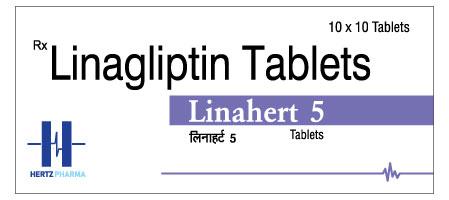Introduction to Linagliptin
Linagliptin, marketed under various brand names such as Linahert 5, is a crucial oral medication prescribed for the management of type 2 diabetes. It belongs to a class of drugs known as dipeptidyl peptidase-4 (DPP-4) inhibitors. Diabetes mellitus type 2 is a chronic condition that affects the body's ability to regulate blood sugar, primarily because of insulin resistance or insufficient insulin production. This medication plays a significant role in controlling blood sugar levels in individuals who cannot manage their diabetes with diet and exercise alone.
Linagliptin works by enhancing the body's ability to release insulin, particularly after eating. It increases the levels of incretin hormones, which are crucial for insulin secretion and the regulation of glucose production. The medication is taken orally, typically once a day, and it can be used on its own or in combination with other diabetes medications such as metformin or insulin to ensure effective blood sugar control.
Mechanism of Action
Linagliptin's primary mechanism of action involves inhibiting the enzyme DPP-4, which breaks down incretin hormones like GLP-1 (glucagon-like peptide-1) and GIP (glucose-dependent insulinotropic polypeptide). These hormones are naturally produced in the gut and play a key role in stimulating insulin release and reducing glucagon levels, especially after meals. By inhibiting DPP-4, linagliptin prolongs the activity of these incretin hormones, leading to more effective regulation of blood sugar levels.
One of the major benefits of DPP-4 inhibitors like linagliptin is their ability to enhance the body’s own glucose-dependent insulin response. Unlike some other diabetes medications, linagliptin does not force the pancreas to release insulin regardless of blood sugar levels, which reduces the risk of hypoglycemia (low blood sugar). Additionally, linagliptin has minimal effects on body weight, making it an attractive option for patients concerned about weight gain, a common side effect of other diabetes treatments.
Dosage and Administration
Linagliptin is typically prescribed as a once-daily oral tablet, with the usual recommended dose being 5 mg per day. One of the advantages of linagliptin is that it can be taken with or without food, offering flexibility to patients in terms of dosing schedule. This convenience factor is especially useful for those who lead busy lives and may not always have consistent meal times.
Patients taking linagliptin should continue to monitor their blood sugar levels regularly and adhere to a balanced diet and exercise routine. Although the medication helps to control blood sugar, it is not a cure for diabetes, and maintaining a healthy lifestyle remains critical for managing the condition.
Linagliptin may also be prescribed alongside other antidiabetic drugs, such as metformin or insulin, in cases where monotherapy is insufficient. Combining treatments can provide better control of blood sugar levels, especially in patients with more severe diabetes or those struggling with insulin resistance.
Side Effects and Precautions
Like any medication, linagliptin may cause side effects. While the majority of patients tolerate the medication well, common side effects include upper respiratory infections, nasopharyngitis (inflammation of the nasal passages and throat), headaches, and gastrointestinal issues such as diarrhea. These side effects are generally mild and tend to resolve as the body adjusts to the medication.
In rare cases, linagliptin has been associated with more serious side effects, including pancreatitis, which is an inflammation of the pancreas. Symptoms of pancreatitis include severe abdominal pain, nausea, and vomiting, and patients should seek medical attention immediately if these symptoms occur. Other rare but serious side effects include allergic reactions, such as skin rash, itching, or swelling of the face, lips, or throat.
Before starting linagliptin, patients should inform their healthcare provider about any other medications they are taking, as drug interactions can occur. This is particularly important for patients taking insulin or sulfonylureas, as the combination with linagliptin may increase the risk of hypoglycemia. Additionally, patients with a history of pancreatitis, heart disease, or kidney problems should discuss their conditions with their doctor to ensure that linagliptin is a suitable option.
Clinical Benefits and Use in Special Populations
Linagliptin has been extensively studied in clinical trials, demonstrating its effectiveness in lowering blood sugar levels in patients with type 2 diabetes. Its glucose-lowering effects are consistent across various populations, including the elderly and those with mild to moderate kidney impairment. Unlike some other diabetes medications, linagliptin does not require dose adjustments for patients with kidney disease, which makes it a favorable option for a broader range of individuals.
For elderly patients or those at risk for kidney problems, linagliptin’s safety profile offers a key advantage over other diabetes medications, many of which require careful monitoring or dosage adjustments in these populations.
Conclusion
Linagliptin (Linahert 5) is a valuable tool in the management of type 2 diabetes, offering effective blood sugar control with a low risk of hypoglycemia and minimal impact on body weight from Hertzpharma. By enhancing the body’s natural insulin response and reducing glucose production, linagliptin helps patients achieve better glycemic control. It is generally well-tolerated, but patients should remain vigilant for potential side effects and consult their healthcare provider regularly to ensure the medication is working effectively for them. Through a combination of medication, diet, and lifestyle modifications, linagliptin can help individuals with type 2 diabetes lead healthier lives.
